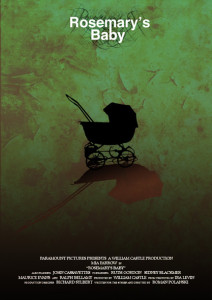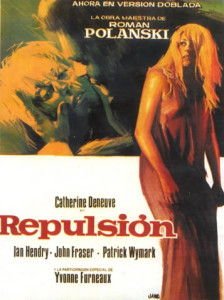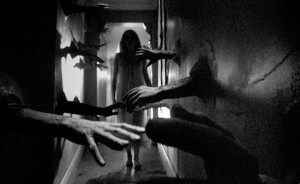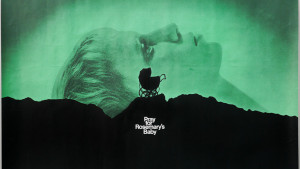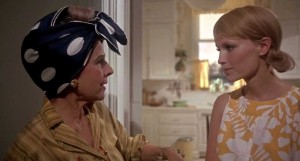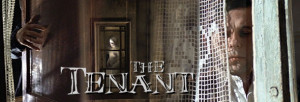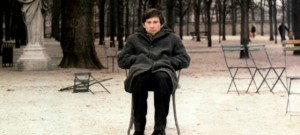“I’m sorry to bother you, I was told about an apartment.”
So Roman Polanski asks in the opening line of The Tenant, in what feels like a not-so-subtle wink at an audience preparing to watch the last in his trilogy of horror films known as his unofficial “Apartment Trilogy”—a trinity of horror films linked by their shared setting of an apartment as the feature setting for the horrors of the premise to unfold. As different as the three films remain in scope and story, the trio that consists of Repulsion, Rosemary’s Baby, and The Tenant each use the confined apartment setting as a vehicle to explore larger allegories of the horrors at hand, with each film also depicting a main character battling the possibilities of mental illness and a supernatural terror threatening the safety of their sanity. In doing so, Polanski’s trilogy successfully manages to push the parameters of the horror genre while also exploring larger thematic issues of gender, identity, and mental illness.
Released in 1965, Repulsion marks the first of the trilogy and remains a tour-de-force character-study into the troubled psychology of a young woman named Carol (a doe-eyed Catherine Deneuve). The paradoxical Carol works as a manicurist in a beauty parlor (despite constantly biting her own nails) who is left alone in her sister’s apartment after she leaves with her boyfriend for a vacation. With amazingly wide-eyes, a demure voice, and constantly uncomfortable body-language, Deneuve portrays a woman in a constant battle to reciprocate the basic human emotions provided through social interactions—especially with men. For reasons that will become clear by the ending, Carol has been traumatized by a rough relationship with men since childhood and the experience has left her a shattered shell of a human being—a woman barely capable of holding conversation and driven to near mental collapse by the smallest imperfections.
Early in the film, her sister’s boyfriend has left his toothbrush within Carol’s space, and she lashes out at the violation. This seemingly small intrusion of boundaries marks the beginning of Carol’s trouble with those (again, especially men) trespassing her private space (most especially within the bathroom [the most private possible room]) that will only worsen within this very confined setting of a small Belgian apartment.
While many filmmakers often believe a larger space intimates a more powerful scope, Polanski uses every possible cinematic technique to demonstrate how unbelievably horrifying a simple apartment can transform itself into the most hellish domain imaginable when filtered through the warped psychology of young Carol. Polanski uses the power of repetitive sounds to maximum distortion and discomfort: the incessant ticking of the clock, the torturous dripping of water, the creaks and groans of wooden floors to methodically construct a tortuous glimpse into the everyday life of this traumatized woman. These sounds so representative of mundane life—the ticking clock, the knock at the door, of passersby on the city streets below—no longer reflect the harmless consequence of suburban life, but the chaotic and disorienting noise heard by a woman suspicious of these formerly benign objects that have now transformed into totems representing the terror of her haunted mind.
Polanski further amplifies this heightened, unnerving reality through the use of innovative visuals and cinematography: shadows, unwarranted reflections, uncomfortable close-ups, and optical illusions are all employed to create an even more literal deconstruction of the classical comforts of the home. Whether it be through the jump-scare of the sudden reflection in her dressing mirror, or the visual illusion of decreasing the dimensions of the room to heighten Carol’s accelerating mental suffocation, Polanski repeatedly demonstrates how even the most conventional objects and spaces can suddenly serve as the most horrifying representations of abject terror.
Besides these cinematic tools used to usher the audience into her horrifying psychology, the film also repeatedly depicts Carol’s crumbling mindset through an assortment of symbolic imagery. Cracked surfaces serve as the most obvious example and are seen multiple times both within the apartment and Carol’s very limited outer world. On a sidewalk, a deep fissure spider-webbing upon the pavement causes Carol to completely still—her eyes magnetized to the crack as though hypnotized. As days go by, she continually hallucinates more cracks spreading across the apartment—fracturing upon the walls in tandem with her increasing neuroses—the apartment now acting as a material manifestation of her warped mental state.
Later, as her hallucinations grow more intense and vivid (a man molesting her becomes repeated multiple times), male hands literally emerge from the wall to claw and grasp her. In credit to the relentless atmosphere of dread, this striking visual becomes a perfect metaphor for how terrifying Carol’s world has come to reflect her poisoned inner-psychology. Even within what should be her most private and secure space—her apartment—Carol’s mind conjures up an unyielding demonstration of her interior psychology and how the traumatizing horrors of her subconscious have transformed into her tangible reality.
Lastly, Carol’s character demonstrates the painful reality of a woman battling this constant war of a collapsing psyche against the horrors of her past. Opening with a close-up of her big brown eye, constantly gazing about the space and studying those around her, Carol’s neuroses become quickly apparent: she constantly bites her nails, brushes her hair, speaks meekly…Her appearance and cleanliness moves past the point of concern and into obsession. As a woman who works in a beauty shop—an establishment literally made to emphasize beauty—Carol can no longer function in society while struggling so drastically with her own mind.
From the ceaseless hounding from men, to enduring the sounds of her sister having sex through the thin apartment walls, to living across from a convent of ostensibly “pure” nuns in the neighboring courtyard, to the endless badgering from men who refuse to accept “No”—Carol finally breaks. The apartment landlord arrives to collect the rent and Carol allows him into the apartment from which she has lived in seclusion and squalor. The landlord makes a number of references to her nightgown, which escalates into an attempted rape, only for Carol to stop the attack by killing him.
When Carol’s sister finally arrives home, she and her boyfriend find both the dead body of the landlord, along with Carol—though she remains in an apparently catatonic state. The other tenants filter into the crammed space suddenly concerned for her well-being. While Carol’s ultimate fate remains ambiguous, her last actions are shown to be combing her hair, ironing a dress (the camera takes careful note of the iron’s unplugged cord) and finally in bed—she begins floating toward the ceiling in hallucinatory freedom. One could certainly make the argument that this represents Carol’s attempt at suicide—as woman overwhelmed with repulsion for the world around her—and needing to leave this world behind her so she can finally escape from the relentless deluge of her traumas.
And while this final fate may remain ambiguous, the last shot certainly shines some light toward what may be the initial catalyst that contributed toward Carol’s utter mental breakdown. After being carried away from the apartment, the camera pans across the room until finding an old family portrait from Carol’s youth. Mirroring the opening close-up of Carol’s eye, the camera zooms uncomfortably close upon the eye of a much younger Carol—her gaze filled with repulsion and directed toward what appears to her father seated directly beside her.
This final shot leaves a haunting, disturbing final impression upon the viewer to fill in the blanks about Carol’s family life and why she has been so psychologically damaged by men. Moreover, the fact that this specific explanation does not appear until the final shot addresses how universally understood this overall psychological struggle can be related upon women at large. As a result, Polanski demonstrates how profoundly the devices of the horror genre can be used to address these larger thematic issues, and even more impressively, uses an atmosphere of persistent dread to transport the viewer into such a troubled psychological mind.
The middle installment—Rosemary’s Baby—would prove to not only be the best of the trilogy, nor just one of the best horror movies ever made, but one of the greatest entries into the film canon at large. The premise revolves around a woman named Rosemary Woodhouse, and her husband, Guy, who have just moved into the Bramford—an older New York apartment building. And immediately, the apartment reeks of ominous details: the previous owner went senile, an enormous wooden secretary has been strangely positioned in front of a closet door, legends of witchcraft are reported to have occurred at the same address, an unnerving chant echoes through the walls…
But worst of all, they meet the Castevets: an elderly couple named Roman and Minnie that live down the hall and make excessive efforts to ingratiate themselves into the lives of the new tenants. Soon after, another series of suspicious events start to surface: a young woman living with the Castevets commits suicide just after meeting Rosemary, Guy’s career skyrockets after a secret conversation with Roman, Minnie insists on Rosemary wearing a “good luck” charm of a mysterious herb within a pendant, and finally—Rosemary suddenly finds herself pregnant. The pregnancy arriving, of course, after a horrifying nightmare in which she is raped by the devil.
Immediately upon hearing the news, Roman and Minnie seize upon the situation to become an unavoidable fixture in the couple’s life: referring Rosemary to an exclusive doctor, delivering daily supplements of their specific herb, and essentially isolating Rosemary from any other contact with outsiders beyond the apartment. As weeks go by, Rosemary pieces together the horrific evidence directly related to her pregnancy—and correctly suspects that she is now pregnant with the son of the devil.
While much of Repulsion’s power relies on Polanski’s deft manipulations of cinematic techniques to highlight the extreme psychosis of the protagonist, Rosemary’s Baby works so successfully through an approach of complete contrast in presenting the narrative as objective, removed, and stylistically distanced as possible. While there are two dream sequences and a rapidly edited climax following Rosemary’s attempt to escape her captors, Polanski shoots the vast majority of the scenes without the aid of the stylistic flourishes that made Repulsion so distinct. Whereas the weight of dread in the former film became constructed through such a singular glimpse into this particular female’s point-of-view, the dread of Rosemary’s Baby emerges through a command of unwavering reality.
Indeed, what has allowed for the film’s reputation and unique nature compared to most horror films relies in the slow descent into the horror of the premise—rather than through shock, jump-scares, and moments that may veer too far from reality as to break the barriers of verisimilitude. Ruth Gordon’s portrayal of Minnie Castavet serves as perhaps the best example of how this particular portrayal of a monster can remain so disturbing. Rather than a performance that hinges on leering, creepy machinations, Gordon’s casting presents an affable, grandmother-like figure whose ostensibly good-natured demeanor diminishes any doubts toward obvious malevolent intentions that she may harbor.
Furthermore, the narrative’s greatest strength comes from repeating this effect throughout almost every turn of the plot. The actions of those surrounding Rosemary—from her husband, to the Castavets, to the tenants—all present themselves with an outward appearance of those with the best intentions for Rosemary.
Consequentially, a frustrating urge arises within the audience—an insuppressible cry to reach out and help Rosemary as those around her cast doubts upon her sanity. Nonetheless, Polanski never releases the audience from this plea to help the pregnant protagonist. Instead, he raises the stakes at every possible point: as Rosemary is manipulated by the malicious forces around her, as Rosemary complains of a horrific pain in her stomach and prohibited from seeing any other doctors, as she grows abnormally thin and pale despite her pregnancy…Polanski refuses to release his suffocating grip upon the viewer, demanding their anxiety to rise in equally uncomfortable parallel with Rosemary’s.
In effect, Polanski positions the audience directly within Rosemary’s psychology, much as he did with Carol in Repulsion, though through incredibly different methods. While Polanski frames the claustrophobia of the apartment in Repulsion as a means of discomfort, the apartment in Rosemary’s Baby is used for exactly the opposite effect—to comfort. The tenants of the Bramford apartment building suffocate Rosemary with their unending help and insistence that she need not leave the apartment. When Rosemary escapes their clutches and tries to find another doctor for a second opinion, the tension rises to an almost unbearable weight of dread. She has finally fled the imprisonment of her own home, and every second grows fraught with the fear that she will again be caught and returned back to her apartment for good.
And of course, this is exactly what happens. After delivering the baby, Rosemary sneaks into the Castevets’ apartment, only to find that her baby remains alive and under the care of the cult composed of the apartment tenants. While her initial reaction is one of absolute horror and shock, the film ends on a semi-ambiguous note as Rosemary cradles her child (conceived by Satan) and seems at a sudden peace. As the camera pans out for end credits to roll, over a wide shot of the expansive apartment complexes that mirror the opening, Rosemary’s fate appears sealed. Rather than fight the oppressive rule of her captors, she appears to have finally surrendered—content to be a prisoner of the apartment if it means being with her baby—consequences be damned.
The last in the trilogy—The Tenant—explores yet another intensely psychological character study, though this time with a man taking center stage. That man is Trelkovsky, as played by Polanski himself, serving as both director and star. As with Rosemary’s Baby, The Tenant opens with a similar, ominous foreshadowing with the owner introducing the new apartment and explains that the previous tenant—a woman named Simone—committed suicide (with Trelkovsky noting “I’ll never understand suicide”). Though Trelkovsky seems suspicious of the incredible austerity of those surrounding the apartment, and the circumstances of the previous tenants death, he accepts the terms and agrees to move into the apartment.
Yet very quickly, these suspicions that start out as simple inconveniences become realized as the true horrors. The neighboring tenants’ dislike for noise grows into an outright contempt, and Trelkovsky’s own identity slowly dissolves into one that he no longer recognizes. As the neighbors begin subtly pushing Trelkvosky into living a life not unlike Simone—the previous tenant—Trelkvosky recognizes that he is slowly transforming into the identity of the woman who previously tenanted the apartment.
Watching the film with ideas of its own historical context in mind—coming after the Manson murders of Polanski’s wife, Sharon Tate—and with Polanski starring as Trelkvosky, one can’t help but watch the narrative without projecting certain ideas about Polanski’s own individual troubles of his personal life upon his fictional one. While The Tenant negotiates between these various themes—identity, paranoia, privacy—and there are certainly some memorable moments that mirror the best in Polanski’s career, the levels of dread and are not as strong as the former two of the trilogy. While they don’t necessarily need to be compared, as they are very different films with very different ambitions, The Tenant stands as a very different film, not only within the Apartment trilogy but Polanski’s overall filmography.
Still, The Tenant wrestles with these ideas in an ever-compelling manner. The escalating sense of terror remains, though not as singularly focused, and the final shot before Trelkovsky stares out the window in a full embrace of his changed identity into Simone—with all the other apartment tenants clapping and urging him on—remains one of the most gorgeously haunting moments in all of Polanski’s work.
Through each film, Polanski illumines dark corners of human neurosis and psychological trauma as few horror films have ever so successfully managed. Whether through the resurrection of past traumas in Repulsion, the spiraling paranoia of Rosemary’s sanity for herself and her baby in Rosemary’s Baby, or the crumbling sense of disillusionment within The Tenant, Polanski’s apartment trilogy uses the power of the horror genre to profound effect as comparative allegories of the true horrors of human psychology. In doing so—and by isolating the characters within the most confined and pocketed corners of an apartment landscape—Polanski demonstrates that the most terrifying ideas are often not the fictitious and supernatural, but that the most horrifying of all evils are those that can be found within the darkest corners of the human mind.

